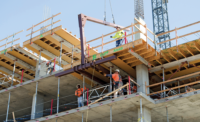"Because we redesigned the overall project management, our project managers have more time for this exchange, and the result has been much greater efficiency and an improved bottom line," Garrett says.
The bottom line has also been strengthened by investing in efficient screw guns, building information modeling (BIM), robotics and offsite cutting strategies.
At the recently completed 1.85-million-sq-ft Levi's Stadium in Santa Clara, the firm used a toolkit of technologies. To design and install the 18,500-sq-ft metal- stud-and-drywall "origami" ceiling in the stadium's BNY Mellon Club East, crews began with BIM to ensure a complete framing model to align with the scopes of the other trades.
The finished ceiling includes 34 unique knife-edged panels, each at different elevations, at different angles and set from an interstitial ceiling to create the floating effect.
"The BIM and detailing eliminated guesswork between trades and allowed us to complete conflict resolution before construction began," says Steve Eckstrom, a co-principal and president.
In addition, California Drywall contracted with SANDIS, a Sunnyvale-based site surveyor, to use robotic stations that provide precise measurements for layout points. Together with shop drawings, the layout teams used these points to precisely establish the location of the panels in the field.
This technology was also used to ensure the correct placement of the curved panels that comprise the ceilings and walls at Stanford University's Bing Concert Hall, which was selected as ENR's Best of the Best Project for specialty contracting. It also won the Association of Wall & Ceiling Industry's 2014 Excellence in Construction Quality award for the complex nature of Bing's compound curves, sculptural surfaces and demanding acoustical and dimensional requirements.
About 18 months ago, the company built a prefabrication shop to cut metal studs and unique panels off site, which can save on labor and material. A stationary computer numerically controlled (CNC) cutting machine cuts drywall into unique shapes for areas such as soffits and curved pieces. The machine has been used on several key projects, including the 257,000-sq-ft Comstock Graduate Housing building at Stanford University, scheduled for completion later this month.
For the $100-million, 438-bed project, California Drywall used the CNC machine to kerf and glue the drywall at the punched window openings. "This greatly reduced the installation time frame of the interior drywall, and the quality was outstanding," says Rod Humble, project executive with general contractor Vance Brown Builders, Palo Alto.
"By utilizing this prefab sequence, we were able to eliminate the corner bead at each punched window, saving us countless man-hours during the taping phase of the project," Humble says. "This reduced the time frame it took to hang, tape and finish each unit."
California Drywall is also using its CNC cutter at several projects for Menlo Park-based general contractor Novo, including the 200,000-sq-ft Softbank US campus in San Carlos and Google Ventures premium offices in Mountain View. For Google, California Drywall designed and installed patios and walkways made from reclaimed wood and installed custom fiberglass walls, says Robert Williamson, a Novo principal.













Post a comment to this article
Report Abusive Comment